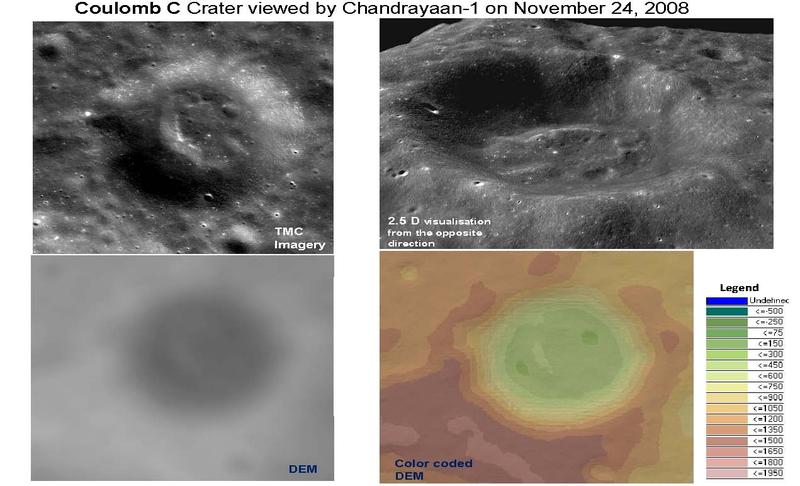Difference between revisions of "January 5, 2009"
| (2 intermediate revisions by the same user not shown) | |||
| Line 1: | Line 1: | ||
__NOTOC__ | __NOTOC__ | ||
=Visualization of an Unimportant Crater= | =Visualization of an Unimportant Crater= | ||
| + | <!-- Start of content --> | ||
<!-- ws:start:WikiTextHeadingRule:1:<h1> --> | <!-- ws:start:WikiTextHeadingRule:1:<h1> --> | ||
<!-- ws:start:WikiTextLocalImageRule:7:<img src="/file/view/LPOD-Jan5-09.jpg/52227111/800x486/LPOD-Jan5-09.jpg" alt="" title="" style="height: 486px; width: 800px;" /> -->[[File:LPOD-Jan5-09.jpg|LPOD-Jan5-09.jpg]]<!-- ws:end:WikiTextLocalImageRule:7 --><br /> | <!-- ws:start:WikiTextLocalImageRule:7:<img src="/file/view/LPOD-Jan5-09.jpg/52227111/800x486/LPOD-Jan5-09.jpg" alt="" title="" style="height: 486px; width: 800px;" /> -->[[File:LPOD-Jan5-09.jpg|LPOD-Jan5-09.jpg]]<!-- ws:end:WikiTextLocalImageRule:7 --><br /> | ||
| − | <em>image from [http://www.isro.gov.in/chandrayaan/htmls/ImageMoon.htm | + | <em>image from [http://www.isro.gov.in/chandrayaan/htmls/ImageMoon.htm ISRO Chandrayaan-1]</em><br /> |
<br /> | <br /> | ||
| − | The Indian Space Research Organization has come out with another example of the capability of the Chandrayaan-1 lunar orbiter. Unfortunately, I can not find any text describing exactly what this shows so I will invent an explanation! The upper left view is from the [http://www.isro.gov.in/chandrayaan/htmls/tmc.htm | + | The Indian Space Research Organization has come out with another example of the capability of the Chandrayaan-1 lunar orbiter. Unfortunately, I can not find any text describing exactly what this shows so I will invent an explanation! The upper left view is from the [http://www.isro.gov.in/chandrayaan/htmls/tmc.htm Terrain Mapping stereo Camera] of the 34 km wide farside crater Coulomb C. This image and a second one (not shown) from when the space crater moved ahead in its orbit allowed a digital terrain model (DTM) to be constructed using the offsets of features when seen in stereo from the two slightly different look directions. This is a standard technique for the Earth but works better on the Moon because there is no atmosphere to cause complications and no water or vegetation to hide the surface. The image at bottom left is the resulting DTM with shades of gray representing different elevations. Colorizing the DTM (bottom right) makes it easier to read and creates a contour map. Digitally draping the image (upper left) over the DTM (bottom left) results in a 3-D image (upper right) that can be viewed from any direction. The figure is labeled [http://en.wikipedia.org/wiki/2.5D 2.5 D] because on the computer screen we see a 2 D image of the 3 D object - this is pettifoggery. A goal of Chandrayaan-1 is to construct a high resolution (10 m) topographic map of the entire Moon, and this shows that ISRO can do it. Coulomb C is a pretty nondescript crater - the broad lump on the floor may be a combination of a central peak and material that slumped from the rim. I am pleased to see this new release, but why, oh why didn't they chose a more dramatic feature? <br /> |
<br /> | <br /> | ||
| − | <em>[mailto:tychocrater@yahoo.com | + | <em>[mailto:tychocrater@yahoo.com Chuck Wood]</em><br /> |
<br /> | <br /> | ||
<strong>Technical Details</strong><br /> | <strong>Technical Details</strong><br /> | ||
Who knows?<br /> | Who knows?<br /> | ||
<br /> | <br /> | ||
| + | <p><b>Yesterday's LPOD:</b> [[January 4, 2009|Four* Heavenly Bodies And a Windmill]] </p> | ||
| + | <p><b>Tomorrow's LPOD:</b> [[January 6, 2009|Two for One]] </p> | ||
<hr /> | <hr /> | ||
| + | {{wiki/ArticleFooter}} | ||
Latest revision as of 21:36, 7 February 2015
Visualization of an Unimportant Crater

image from ISRO Chandrayaan-1
The Indian Space Research Organization has come out with another example of the capability of the Chandrayaan-1 lunar orbiter. Unfortunately, I can not find any text describing exactly what this shows so I will invent an explanation! The upper left view is from the Terrain Mapping stereo Camera of the 34 km wide farside crater Coulomb C. This image and a second one (not shown) from when the space crater moved ahead in its orbit allowed a digital terrain model (DTM) to be constructed using the offsets of features when seen in stereo from the two slightly different look directions. This is a standard technique for the Earth but works better on the Moon because there is no atmosphere to cause complications and no water or vegetation to hide the surface. The image at bottom left is the resulting DTM with shades of gray representing different elevations. Colorizing the DTM (bottom right) makes it easier to read and creates a contour map. Digitally draping the image (upper left) over the DTM (bottom left) results in a 3-D image (upper right) that can be viewed from any direction. The figure is labeled 2.5 D because on the computer screen we see a 2 D image of the 3 D object - this is pettifoggery. A goal of Chandrayaan-1 is to construct a high resolution (10 m) topographic map of the entire Moon, and this shows that ISRO can do it. Coulomb C is a pretty nondescript crater - the broad lump on the floor may be a combination of a central peak and material that slumped from the rim. I am pleased to see this new release, but why, oh why didn't they chose a more dramatic feature?
Chuck Wood
Technical Details
Who knows?
Yesterday's LPOD: Four* Heavenly Bodies And a Windmill
Tomorrow's LPOD: Two for One
COMMENTS?
Register, Log in, and join in the comments.



